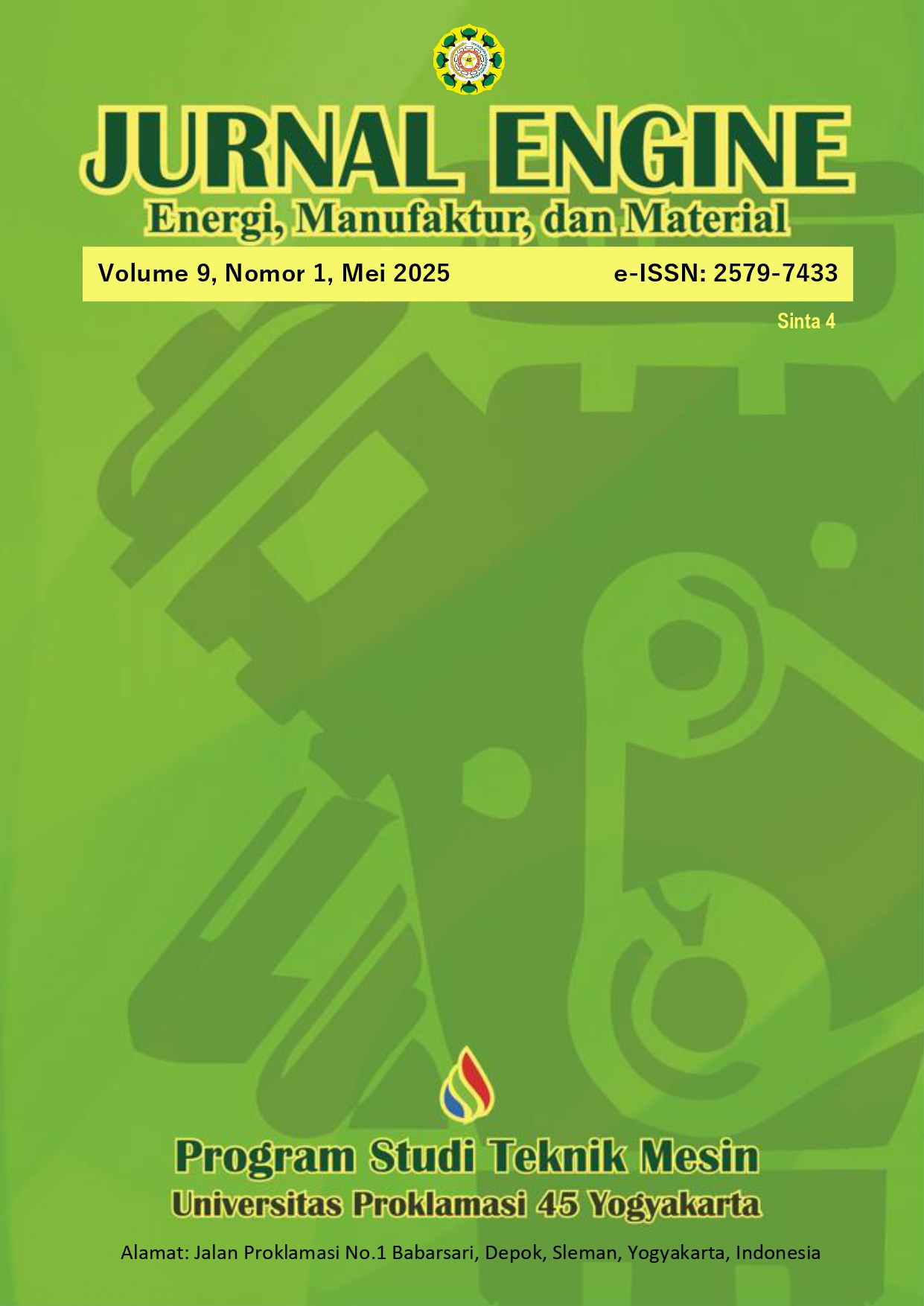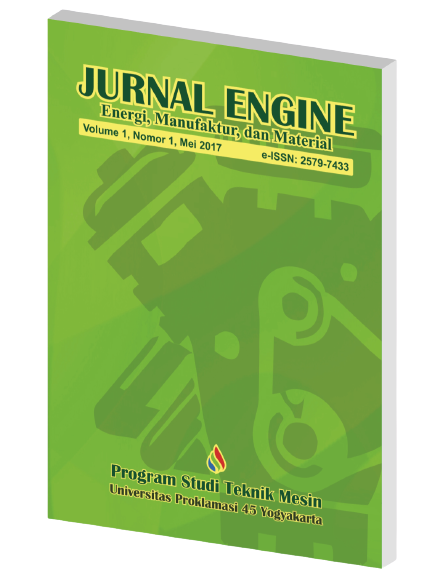Perancangan dan Pembuatan Mesin Pengaduk Sampah Organik
DOI:
https://doi.org/10.30588/jeemm.v9i1.2023Keywords:
design, manufacturing, mixer machine, organic wasteAbstract
Waste is a byproduct of production activities, both in the industrial and household sectors. Solid waste, commonly known as garbage, can be divided into organic and inorganic waste. Organic waste from households, such as food scraps and plant materials like wood, twigs, or leaves, can be converted into compost or organic fertilizer that has economic value. The process of organic waste treatment requires a mixer machine to blend the chopped waste with other additional materials. In this study, the design and construction of an organic waste mixer machine were carried out. The mixing mechanism uses two ribbon-shaped twisted (helical) blades that rotate in opposite directions. As they spin, they produce a rotating movement while shifting to the left and right, creating a more even mixing effect. The shaft and mixing blades are rotated by the main drive, a 1 hp single-phase electric motor with a speed of 1420 rpm. From the electric motor, the speed is reduced using a speed reducer gearbox with a 40:1 ratio, bringing the shaft and blade rotation speed to 35,5 rpm. The mixing force generated on the mixer blade is 752,6 N.
References
Antu, E. S., & Djamalu, Y. (2019). Desain Mesin Pencacah Sampah Organik Rumah Tangga Untuk Pembuatan Pupuk Kompos. Jurnal Teknologi Pertanian Gorontalo (JTPG), 3(2), 57.
Arninda, A., Fitra, F., & Diana, S. (2021). Pra Rancangan Mesin Mixer Pada Pembuatan Pupuk Dari Limbah Kulit Kopi Di Kelurahan Cikoro, Kabupaten Gowa. Seminar Nasional Teknologi Industri VIII 2021, 8(1), 394–399.
Darmanto, S. (2013). Rancang Bangun Mesin Pengolah Pupuk Kotoran Sapi. TRAKSI Majalah Ilmiah Teknik Mesin, 13(1), 4–22.
Ferdiansyah, R. T., & Fauzi, A. S. (2023). Rancang Bangun Mesin Pengaduk Sampah Organik Berkapasitas 50 Kilogram/Menit. Prosiding Seminar Nasional Inovasi Teknologi, 7, 1376–1382.
Frasdianata, R. A., Azharuddin, Effendi, S. (2023). Analisa Pengaruh Kecepatan Putaran pada Mesin Pengaduk Bahan untuk Pupuk Organik terhadap Durasi Pengadukan. Machinery: Jurnal Teknologi Terapan, 4(3), 134-140.
Kementerian Lingkungan Hidup dan Kehutanan Direktorat Jenderal Pengelolaan Sampah, Limbah dan B3 Direktorat Penanganan Sampah (2024). Capaian Kinerja Pengelolaan Sampah https://sipsn.menlhk.go.id/sipsn/, diakses pada 4 April 2024.
Larasati, A. A., & Puspikawati, S. I. (2019). Pengolahan Sampah Sayuran Menjadi Kompos Dengan Metode Takakura. Ikesma, 15(2), 60–68.
Muttaqin, K. I., & Nur, R. (2024). Rancang Bangun Mesin Pengaduk Pupuk Organik Cair (Poc) Design and Construction of Liquid Organic Fertilizer (Poc) Mixing Machine. JTAM Rotary, 6(1), 41–52.
Nugraha, N., Anggraeni, N. D., Ridwan, M., Fauzi, O., & Yusuf, D. (2018). Rancang Bangun Komposter Rumah Tangga Komunal Sebagai Solusi Pengolahan Sampah Mandiri Kelurahan Pasirjati Bandung. Creative Research Journal, 3(02), 105–114.
Pabbenteng, P., & Alwina, E. (2021). Rancang Bangun Mixer Komposter Pada Laboratorium Pengolahan Limbah. Prosiding Seminar Nasional Penelitian & Pengabdian Kepada Masyarakat, 67–71.
Rizsky Agus Frasdianata, Azharuddin, S. E. (2023). Analisa pengaruh kecepatan putaran pada mesin pengaduk bahan untuk pupuk organik terhadap durasi pengadukan. Machinery: Jurnal Teknologi Terapan, 4(3), 134–140.
Suhartoyo. (2021). Rekayasa Mesin Pengaduk Untuk Pembuatan Pupuk Kandang Kotoran Sapi Guna Meningkatkan Kesejahteraan UKM Peternak Sapi. Panrannuangku Jurnal Pengabdian Masyarakat, 1(2), 63–70.
Susanti, R. (2014). Pembuatan Alat Pengadukan Pupuk Kompos Berbasiskan Mikrokontroler. Jurnal Ilmiah Poli Rekayasa, 9(2), 62–73.
Downloads
Published
How to Cite
Issue
Section
License
Copyright (c) 2025 Ignatius Aris Hendaryanto, Galuh Bahari, Radhian Krisnaputra (Author)

This work is licensed under a Creative Commons Attribution 4.0 International License.
Authors who publish with Jurnal Engine: Energi, Manufaktur, dan Material agree to the following terms:
Authors retain copyright and grant the Jurnal Engine: Energi, Manufaktur, dan Material right of first publication with the work simultaneously licensed under a Creative Commons Attribution 4.0 International License that allows others to share (copy and redistribute the material in any medium or format) and adapt (remix, transform, and build upon the material) the work for any purpose, even commercially with an acknowledgment of the work's authorship and initial publication in Jurnal Engine: Energi, Manufaktur, dan Material. Authors are able to enter into separate, additional contractual arrangements for the non-exclusive distribution of the journal's published version of the work (e.g., post it to an institutional repository or publish it in a book), with an acknowledgment of its initial publication in Jurnal Engine: Energi, Manufaktur, dan Material. Authors are permitted and encouraged to post their work online (e.g., in institutional repositories or on their website) prior to and during the submission process, as it can lead to productive exchanges, as well as earlier and greater citation of published work (See The Effect of Open Access).


















